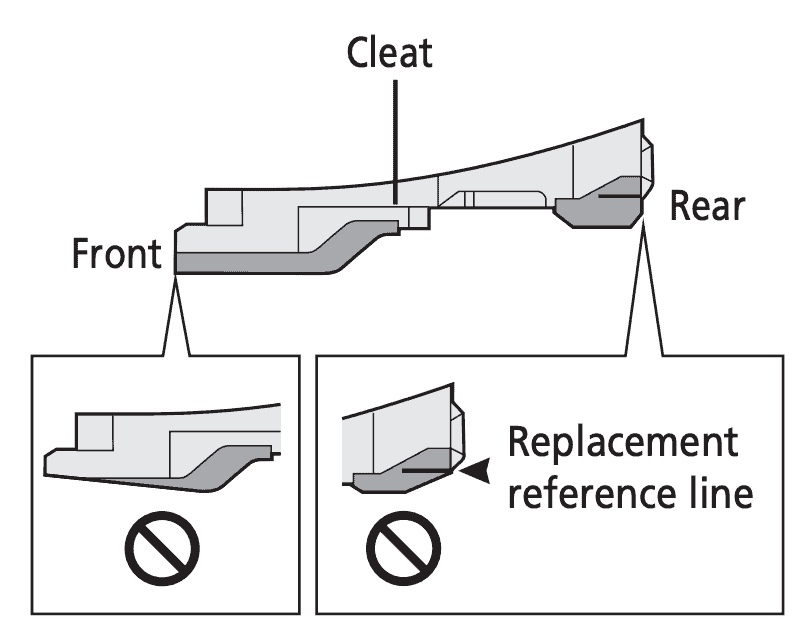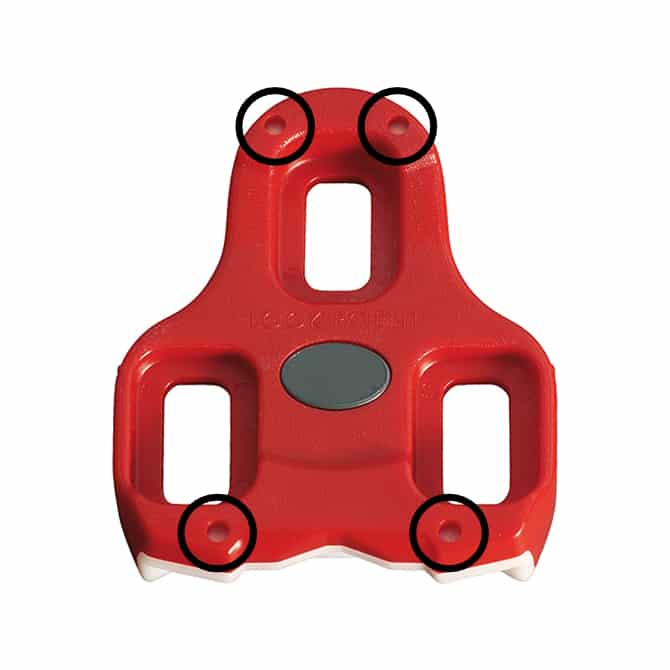This article explains how to check for worn-out cleats for major brands such as Shimano, Look, Speedplay, and Time.
When to replace worn-out cleats?
Here are four common signs indicating it’s about time to replace the cycling cleats with new ones.
- Visible signs of wear, such as the cleats appearing in bad shape or showing cracks, especially on the rubber grips, indicate a need for replacement.
- Wear indicator. Shimano and Look cleats have wear indicators. Replace the cleats once the wear indicators are visible.
- Fore-aft movements when pedaling mean the cleat-pedal contact surface is loose or has tiny gaps. This is usually due to unexpected wear on the cleat surface. Fore-aft movement is different from lateral movement, which is the float angle.
- Shoe unclips unexpectedly. A worn-out cleat doesn’t lock onto the pedals as expected; this usually happens when riding off the saddle.
Cycling cleats wear indicators
Each major pedal brand – Shimano, Look, Speedplay, and Time provides guidelines for identifying when to replace cycling cleats. Let’s delve into each manufacturer’s specific recommendations.
Shimano SPD-SL cleats

Replace Shimano cleats when the black plastic layer underneath the colored (yellow, blue, or red) plastic becomes visible on the front.
For the rear, replace the cleats when the colored layer has worn beyond the replacement line.
LOOK KEO cleats

LOOK KEO cleats have four wear indicators; two at the front and two at the rear underneath the elastomer pads. Replace the cleats as soon as one of the four wear indicators appears.
Speedplay cleats
Speedplay (now owned by Wahoo Fitness) recommends that ‘Cleats be replaced at least every 3,000 to 5,000 miles of use or whenever the parts show visible wear.’
Because the Speedplay system is more complicated and has more parts than Shimano and Look, replace all the used parts. Do not use a combination of old and new cleat parts.
TIME cleats
TIME (now owned by SRAM) pedals are somewhat vague in their recommendations to replace cheats.
According to TIME, ‘we recommend replacing cleats if release from the pedal becomes more difficult or if the walking tabs on ICLIC cleats become worn.’
Why replace worn-out cleats?
Cleats are one of the consumables besides tires, chains, and bar tapes. They’re relatively cheap ($20 to $30) to replace. Here are some reasons why you should consider replacing the cleats.
- Safety. A worn-out cleat poses a risk to yourself and the group you’re riding with. Worn-out cleats can cause you to unclip unexpectedly, especially when riding off the saddle.
- Grip. The small rubber pieces beneath the cleat provide grip when we’re walking. Walking around with worn-out cleats can be slippery and causes you to slip and fall.
- Efficient power transfer. Worn-out cleats can be a frustrating experience when you’re putting the power down as the pedal-cleat interface is loose. A 1mm gap will feel like the entire pedal is coming loose.
FAQ
How often should I check my cycling cleats for wear?
From my experience, it’s a good habit to do a quick visual check of your cleats after each ride, especially if you’ve tackled some challenging or rough terrain. However, a more thorough inspection is recommended every 1,000 miles or so, typically when signs of wear start to appear.
What happens if I don’t replace my worn-out cycling cleats?
I’ve found that persisting with worn-out cleats can be quite risky. They can compromise your safety by causing unexpected unclipping, potentially leading to falls or loss of control. Wearing cleats can greatly reduce your grip when walking in cycling shoes; I’ve had a few slippery moments myself in the past too.
Is it necessary to have a professional replace my cycling cleats, or can I do it myself?
Having replaced my own cleats multiple times, I can tell you that it’s a task most cyclists can handle at home with the right tools and a good set of instructions. But, if you’re feeling uncertain or it’s your first time, it’s always wise to consult a professional to ensure it’s done correctly.
Will all types of cleats fit my cycling shoes?
Unfortunately, not all cleats are universally compatible with all cycling shoes.
I have seen this happen often when someone bought the wrong type of cleats for their shoes and/or pedals. It’s important to confirm the compatibility between your shoes and the Shimano, Look, Speedplay, or Time cleats before purchasing.
How can I extend the lifespan of my cycling cleats?
To keep your cleats in tip-top condition for as long as possible, try to minimize walking in your cycling shoes. If walking is unavoidable, consider using cleat covers.

Alex Lee is the founder and editor-at-large of Mr. Mamil. Coming from a professional engineering background, he breaks down technical cycling nuances into an easy-to-understand and digestible format here.
He has been riding road bikes actively for the past 12 years and started racing competitively in the senior category during the summer recently.